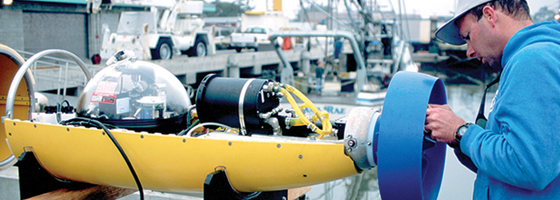Alliance for Coastal Technologies helps keep environmental sensors moving forward

Around a decade ago, a branch of the federal government that funds research and development for environmental sensor technology wasn’t satisfied with its return on investment.
“They would get a prototype at a lab bench that a university professor and his post-doc could run, but they weren’t really seeing an operational tool that they could use and the community could use,” said Mario Tamburri, professor at the University of Maryland Center for Environmental Science. “They wanted a program to help push those technologies along and take over where traditional funding sources stop.”
That led to the Alliance for Coastal Technologies, or ACT. Funded by the National Oceanic and Atmospheric Administration, the program is a partnership between university research institutions, environmental agencies and technology manufacturers. The group is also a part of the Integrated Ocean Observing System. ACT works to advance environmental sensors development, helping manufacturers strengthen the weak spots in their products while educating users on how to get the most out of their tools.
“Our goal in evaluating technologies is to provide a resource both to the people who develop and sell these instruments and the users,” said Tamburri, who also serves as the director of the alliance.
One of the program’s most important jobs is to serve as an independent, unbiased testbed for emerging technologies, as well and established tools that are already on the market. For off-the-shelf products, an ACT evaluation puts an instrument through its paces in diverse environments, including the Great Lakes, Chesapeake Bay, and the coastal waters of Hawaii and Alaska. Lab tests give a controlled look at a tool’s performance in areas like accuracy, precision and range.
Though the group issues a report on each tool that describes the results of the evaluation, they stay away from recommending one product over another. That would change their relationship with the manufacturers, whose participation is crucial to the ultimate goal of improving technology, Tamburri said.
“We don’t want to alienate them in any way,” he said. “But they know going in, that because we’re a federally funded effort, that all the data is made publicly available. So they know that good, bad or otherwise, the data is going to be out there.”
An upcoming round of testing will focus on pH sensors. The ability to measure pH in situ has become increasingly important as scientists seek to better understand ocean acidification, which is tied to the ocean carbon cycle.
Although technology for measuring pH is widely available, the probes are prone to fouling.
“That’s always been a challenge as soon as you put those instruments in the water. An hour or two later, how reliable are those readings?” Tamburri said. “How good are those numbers, and how good are they over time, is our first big question.”
In addition to evaluating tools that are already widely used, ACT also runs tests to demonstrate emerging technologies. The group most recently performed this kind of demonstration on environmental sensors that measure partial pressure of carbon dioxide, another important parameter in understanding the ocean carbon cycle. That analysis found that the sensors work, but require a level of expertise about small issues that can make a big difference in the readings.
“You have to know what you’re doing,” Tamburri said. “But I think that is one of those issues that can be overcome. The more we learn about this, and the more they’re packaged better, the more user-friendly they are and the better those readings are going to be.”
One reason to believe these issues will be resolved is that, not long ago, the industry was in a similar situation with another set of relatively young sensors tied to an emerging environmental issue.
Though resource managers at the time were becoming increasingly aware of algal blooms and hypoxia caused by excess nutrients, they didn’t trust the nascent technology that would allow them to capture high-resolution data on nitrogen or phosphorous in their water bodies. The instruments were expensive and were prone to clogging or other issues, and people were more comfortable with collecting samples and measuring phosphorous in the lab.
An evaluation of nutrient sensors found that the fundamental measurement technology was sound, Tamburri said. The packages housing the sensors were causing most of the trouble. The collaboration with ACT helped the manufactures identify and resolve mechanical issues with the packages. Meanwhile, the group worked with users to alleviate some of the anxiety over transitioning to a new measurement approach.
“I think those nutrient analyzers are very operational now,” Tamburri said. “And I hope that ACT played a large role in making that possible.”





0 comments